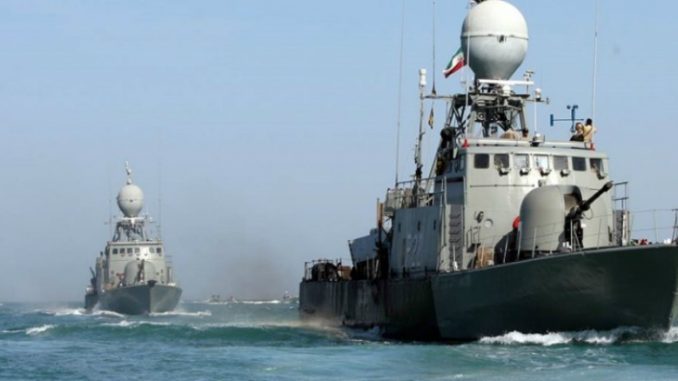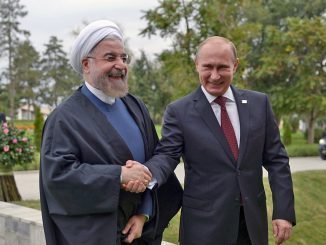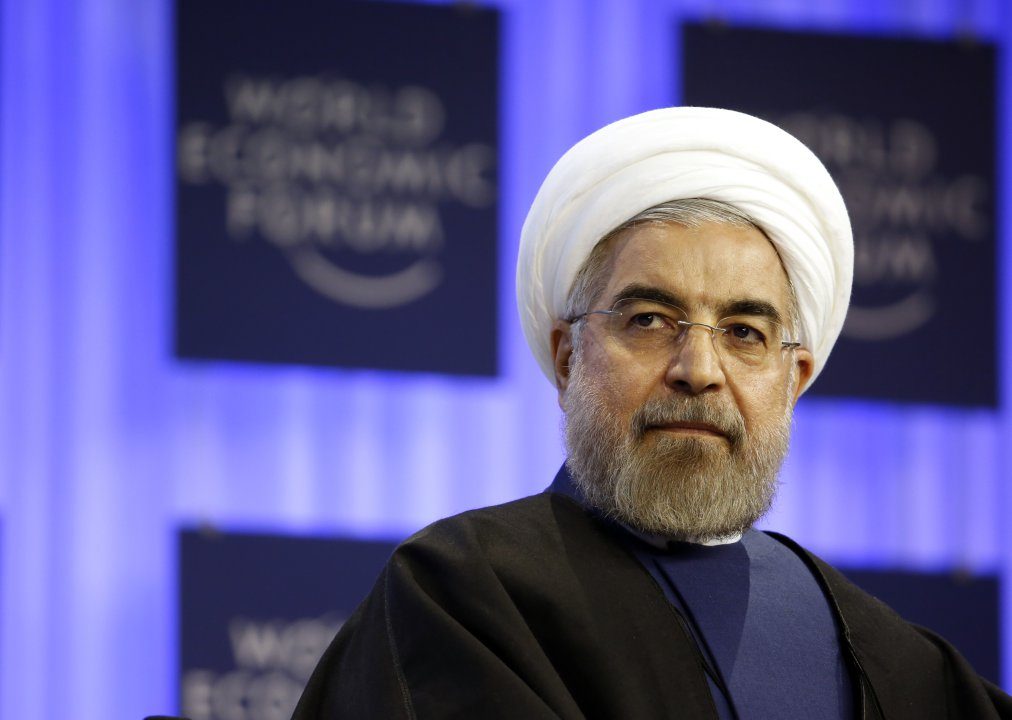
Iran launched new naval drills at the mouth of the Gulf and the Indian Ocean on Sunday, a naval commander said, amid increasing tension with the US and the regional powers.
Trump has said during his election campaign that Iran’s nuclear deal as “disastrous” and said it would be his “number one priority” to dismantle it.
These threats became clearer after Trump’s inauguration, as he signed an executive order temporarily barring thousands from seven countries in the Middle East and Africa, including Iran, from obtaining visas to travel to the United States.
The tension was raised again in issues related to Iran’s ballistic program, as he said that “Iran is playing with fire” and announced that “we’re officially putting Iran on notice,” after Iran conducted a failed ballistic missile test.
In addition, Trump declared in January applying sanctions on 25 individuals and companies connected to Iran’s ballistic missile program and those providing support to Iran’s Islamic Revolutionary Guard Corps’ Quds Force.
Recently, US senators said plan to impose new sanctions on Iran over its ballistic missile program, while Israel and Saudi Arabia backed these measures and described Iran as the main sponsor of global “terrorism” and a destabilizing force in the Middle East.
New naval drills
Iran’s annual exercises will be held in the Strait of Hormuz, the Gulf of Oman, the Bab el-Mandab and northern parts of the Indian Ocean and will cover an area of 772,000 square miles, to train in the fight against terrorism and piracy, Rear Admiral Habibollah Sayyari said, according to state media.
Millions of barrels of oil are transported daily to Europe, the United States and Asia through the Bab el-Mandab and the Strait of Hormuz, waterways that run along the coasts of Yemen and Iran.
Navy ships, submarines and helicopters will take part in the drills across an area of about 2 million square kilometers (772,000 square miles) and marines will showcase their skills along Iran’s southeastern coast, the state news agency IRNA said.
Apart from the main drills, Iran’s Navy commando units are conducting special operations in the southeastern Makran region.
The U.S. Navy’s 5th Fleet, based in Bahrain, declined to comment on the exercise or discuss if it had any plans to monitor the drill.
The move comes just two weeks after Western navies held a series of drills off the coast of Iran last week, in a show of force in light of increased Iranian harassment of foreign military vessels.
The exercises, dubbed “United Trident,” were led by the United Kingdom and included ships from the US, France and Australia. The navies practiced fighting off enemy aerial incursions and mine clearing, as well as live fire drills.
The final drill featured 13 ships from the allied navies sailing in formation, with helicopters flying overhead.
Last month, Iranian Navy Commander Rear Admiral Habibollah Sayyari was dismissive of the show of force close to Iranian waters, warning the Western navies against encroaching on Iranian waters, saying, “This is our red line.”
Iran’s navy routinely holds war games it says are aimed at improving its readiness against threats. It also sends its warships to international waters off the Gulf of Aden to fight piracy.
However, the drill does not involve Iran’s elite Revolutionary Guard (IRGC), a paramilitary force the U.S. Navy often criticizes for harassing its vessels, as those forces have made separate war games last week.
Military War games by IRGC
On Wednesday, the Revolutionary Guards concluded three days of exercises with rockets, artillery, tanks, and helicopters, weeks after Trump warned that he had put Tehran “on notice” over the missile launch.
Codenamed “Payambar-e Azam 11 (The Great Prophet)”, the military exercise was launched on Monday under the motto of “Presentation of Power and Sustainable Security” to boost the country’s military might with rockets, artillery, tanks, and helicopters.
Commander of IRGC Ground Force Brigadier General Mohammad Pakpour told reporters on Wednesday that the drills were intended to send a message to “global arrogant powers”.
“The enemy should not be mistaken in its assessments, and it will receive a strong slap in the face if it does make such a mistake,” said General Mohammad Pakpour.
“The message of these exercises … for world arrogance is not to do anything stupid,” said Pakpour, quoted by the semi-official news agency Tasnim.
“Everyone could see today what power we have on the ground.” The Guards said they test-fired “advanced rockets” and used drones in the three-day exercises which were held in central and eastern Iran.
As tensions also mounted with Israel, a military analyst at Tasnim said that Iran-allied Hezbollah could use Iranian-made Fateh 110 missiles to attack the Israeli nuclear reactor at Dimona from inside Lebanon.
Hezbollah leader Sayyed Hassan Nasrallah said last Thursday that his group, which played a major role in ending Israel’s occupation of Lebanon, could strike Dimona.
“Since Lebanon’s Hezbollah is one of the chief holders of the Fateh 110, this missile is one of the main alternatives for targeting the Dimona installations,” Hossein Dalirian said in a commentary carried by Tasnim.
Threats never work with Iran
In the same context, Iranian Foreign Minister Mohammad Javad Zarif said the recent US bans imposed on Iran, the first by the US government since President Trump took office on January 20, and said sanctions would never work with Iran
“Everybody [in] the past who has tested Iran knows we don’t respond well to threats. We respond well to mutual respect and mutual interests,” the Iranian foreign minister added.
He noted that all efforts by the Obama administration to use economic sanctions to curtail Iran’s peaceful nuclear program eventually failed.
“The reason Obama came to the negotiating table was because sanctions did not work,” Zarif said.
“Iran with the backing of the wise participation and support of the great Iranian nation will respond proportionately and reciprocally to any move that targets the interests of the Iranian people,” Zarif said in a statement.
Zarif also said that the nuclear deal will stay in place, despite noises to the contrary from members of US President Donald Trump’s administration.
Zarif added that there was an international consensus not to let the agreement — which took two years to negotiate — unravel.
“I believe everybody, including experts in the United States, knows this was the best deal possible for all concerned, not just Iran but the US too,” he said.
“It was a triumph of diplomacy over coercion because coercion doesn’t work anymore.”



